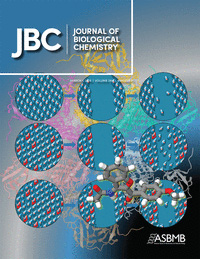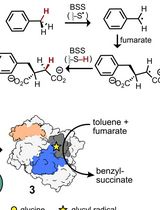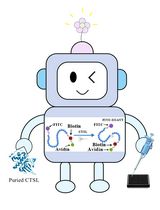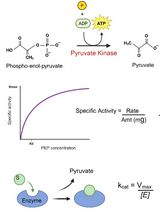- EN - English
- CN - 中文
Measurement of ATPase Activity of Valosin-containing Protein/p97
含缬酪肽蛋白/p97的ATP酶活性检测
发布: 2020年02月05日第10卷第3期 DOI: 10.21769/BioProtoc.3516 浏览次数: 5051
评审: Gal HaimovichSeda EkiciAnonymous reviewer(s)
Abstract
Valosin-containing protein (VCP; also known as p97) is a type II ATPase regulating several cellular processes. Using proteomic techniques, we identified a chemical compound that binds to the D1 ATPase domain of VCP. The protocol described here was to study the effect of the compound on ATPase activity in vitro of purified VCP protein. ATPases are enzymes that hydrolyze ATP in a reaction resulting the release of an inorganic phosphate. This reaction can be measured using several methods, such as colorimetric, fluorescence, and radiometric assays, in addition to the bioluminescence assay mentioned here. Since the remaining ATP level after the reaction was detected using a luciferase assay, the luminescent signal indicates the ATPase activity inversely. This protocol is sensitive, rapid, and can be used for high-throughput screening assays to study the effect of compounds on ATPase function.
Keywords: ATPase (ATP酶)Background
Valosin-containing protein (VCP) belongs to the AAA+ (adenosine triphosphate-hydrolyzing enzymes [ATPases] associated with a variety of cellular activities) family of proteins. It is a 96 kDa protein containing three regions: the N-terminal domain, and the ATPase domains D1 and D2. The D2 domain of VCP is known to show major ATPase activity when compared to the D1 domain (Song et al., 2003). Since D1 domain of human VCP ends at 459th serine, the truncated mutant S459* (459th serine was changed to stop codon) contains only the D1 domain but not D2 domain. Thus we used this mutant to examine the effect of our compound on D1 domain of VCP (Suvarna et al., 2019). NPD8733, a compound from the RIKEN Natural Products Depository (NPDepo) was identified as an inhibitor of cancer cell-enhanced fibroblast migration. Pull-down assay and proteomic techniques revealed that this compound specifically binds to the D1 domain of VCP (Suvarna et al., 2019). The bioluminescence assay reported here was used to study the effect of NPD8733 on the ATPase activity of VCP. ATPases hydrolyze adenosine triphosphate (ATP) in a reaction, which results in the release of an inorganic phosphate (Rule et al., 2016). Most of the methods used for evaluating the ATPase activity measure phosphate release using radioactive (Sanghera et al., 2009), fluorescent (Bastola et al., 2017; Magnaghi et al., 2013), or colorimetric substrates (Song et al., 2003; Rule et al., 2016). All these assays have some drawbacks that include the use of hazardous substrates, long detection time, low sensitivity, and are difficult to be used in high-throughput screening (HTS) assays (Tanega et al., 2009; Sanghera et al., 2009). Here, we applied a bioluminescence assay (Promega) for the detection and measurement of the ATPase activity of purified recombinant VCP protein. This assay measures the remaining ATP levels after ATPase reaction using a thermostable luciferase reagent. Luciferase catalyzes the mono-oxygenation of luciferin using ATP as the substrate. The luciferase reaction generates one photon of light per turnover. The luminescence measured is inversely related to the ATPase activity.
This simple, rapid, and sensitive assay overcomes the limitations of previous techniques. The luminescence signal produced by the luciferase reaction has a half-life greater than five hours (h), which allows processing of multiple assay plates. This technique is less susceptible to interference from NPDepo compounds and, thus, can be used for HTS assays to evaluate the roles of inhibitors (Tanega et al., 2009; Sasazawa et al., 2012). It can also be used to study and characterize the functions of ATPase domains and their specific residues. In addition, the assay can be modified to study other enzymes, such as kinases.
Materials and Reagents
- Solid white multiwell plates (SUMILON, catalog number: MS-8096W)
- Pipette tips (Gilson)
- Aluminum foil
- 1.5 ml Eppendorf tubes
- Spreader (Sarstedt, catalog number: 86.1569.005)
- Petri dish (IWAKI, catalog number: SH90-15E)
- Glutathione S-transferase (GST)-fused VCP and its deletion mutants in a pGEX-2T vector plasmid DNA (gifts from Drs. Masaya Imoto and Etsu Tashiro at Keio University (Sasazawa et al., 2012).Truncated mutant that lacks D2 domain of VCP was constructed by ourselves (Suvarna et al., 2019).
- BL21 Star (DE3) competent E. coli cells (Thermo Fisher Sientific, catalog number: C6010-03)
- Ethylenediaminetetraacetic acid (EDTA) (FUJIFILM Wako Pure Chemical, catalog number: 345-01865, CAS number: 6381-92-6)
- ATP (GE Healthcare, catalog number: 27-2056-01, CAS number: 56-65-5)
- MgCl2 (FUJIFILM Wako Pure Chemical, catalog number: 136-03995, CAS number: 7786-30-3)
- MgSO4 (FUJIFILM Wako Pure Chemical, catalog number: 137-12335, CAS number: 7487-88-9)
- Glucose (FUJIFILM Wako Pure Chemical, catalog number: 049-31165, CAS number: 50-99-7)
- Tris (Sigma-Aldrich, catalog number: 252859, CAS number: 77-86-1)
- NaCl (FUJIFILM Wako Pure Chemical, catalog number: 191-01665, CAS number:7647-14-5)
- 3-[(3-Cholamidopropyl)dimethylammonio]-1-propanesulfonate hydrate (CHAPS) (Sigma-Aldrich, catalog number: C3023, CAS number: 33171745-4)
- KCl (FUJIFILM Wako Pure Chemical, catalog number: 163-03545, CAS number: 7447-40-7)
- Na2HPO4 (FUJIFILM Wako Pure Chemical, catalog number: 196-02835, CAS number: 10039-32-4)
- KH2PO4 (FUJIFILM Wako Pure Chemical, catalog number: 169-04245, CAS number: 7778-77-0)
- Tryptone (Becton Dickinson, catalog number: 211701)
- Yeast extract (Becton Dickinson, catalog number: 212750)
- Agar powder (Becton Dickinson, catalog number: 156783)
- Milli-Q water (Purified water produced by MilliQ Q-POD, Millipore)
- Ampicillin (Sigma-Aldrich, catalog number: A0166, CAS number: 69-52-3)
- Protease inhibitor tablets (ROCHE cOmplete, catalog number: 4693159001)
- Isopropyl-β-D-thiogalactoside (IPTG) (Sigma-Aldrich, catalog number: 10724815001, CAS number: 367-93-1)
- Glutathione Sepharose 4B (GE Healthcare, catalog number: 17075605)
- Reduced glutathione (Sigma-Aldrich, catalog number: G4251, CAS number: 70-18-8)
- Column for purification (Econo-Column, Bio-Rad, catalog number: 7371512)
- N,N'-Dibenzylquinazoline-2,4-diamine (DBeQ; known inhibitor of ATPase activity of VCP; Sigma-Aldrich, catalog number: SML0031, CAS number: 177355-84-9)
- Kinase Glo Plus reagent (Promega, catalog number: V3771, Reference 8)
- Assay buffer (1x; see Recipes)
- ATP solution (see Recipes)
- Kinase-glo reagent (see Recipes)
- DBeQ solution (see Recipes)
- LB agar (250 ml) (see Recipes)
- Cell lysis buffer (see Recipes)
- Elution buffer (see Recipes)
- Phosphate-buffered saline (PBS 10x; 1 L; see Recipes)
- Super optimal broth (SOC) (see Recipes)
Equipment
- Multi-channel pipettes (Gilson)
- Flask (500 ml glass conical flask)
- pH meter (HORIBA, model: D-21)
- Microplate reader (Thermo Fisher Scientific, VarioSkan Lux)
- Sonicator (Tomy, model: UR-20P)
- Vortex (Scientific Industries, Genie 2)
- Standard refrigerated centrifuge for 15/50 ml and Eppendorf tubes (Tomy, model: MX-301)
- Heat block (Scinics, model: ALB-121)
- Air incubator for plate incubation (EYELA, model: MTI-203)
- Water bath (EYELA, model: NTT)
- Shaker (TAITEC, model: BR-15)
Software
- R (R Foundation for Statistical Computing; https://www.r-project.org)
Procedure
文章信息
版权信息
© 2020 The Authors; exclusive licensee Bio-protocol LLC.
如何引用
Readers should cite both the Bio-protocol article and the original research article where this protocol was used:
- Suvarna, K., Honda, K., Muroi, M., Kondoh, Y., Osada, H. and Watanabe, N. (2020). Measurement of ATPase Activity of Valosin-containing Protein/p97. Bio-protocol 10(3): e3516. DOI: 10.21769/BioProtoc.3516.
- Suvarna, K., Honda, K., Muroi, M., Kondoh, Y., Osada, H. and Watanabe, N. (2019). A small-molecule ligand of valosin-containing protein/p97 inhibits cancer cell-accelerated fibroblast migration. J Biol Chem 294(9): 2988-2996.
分类
癌症生物学 > 癌症生物化学 > 蛋白质
生物化学 > 蛋白质 > 活性
您对这篇实验方法有问题吗?
在此处发布您的问题,我们将邀请本文作者来回答。同时,我们会将您的问题发布到Bio-protocol Exchange,以便寻求社区成员的帮助。
Share
Bluesky
X
Copy link













